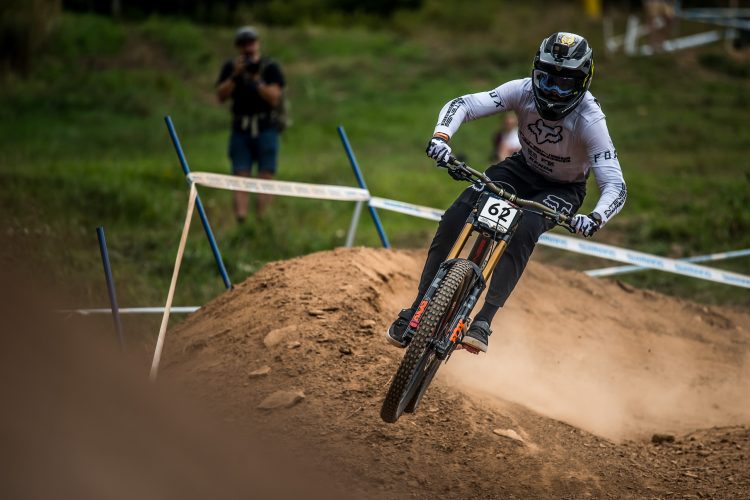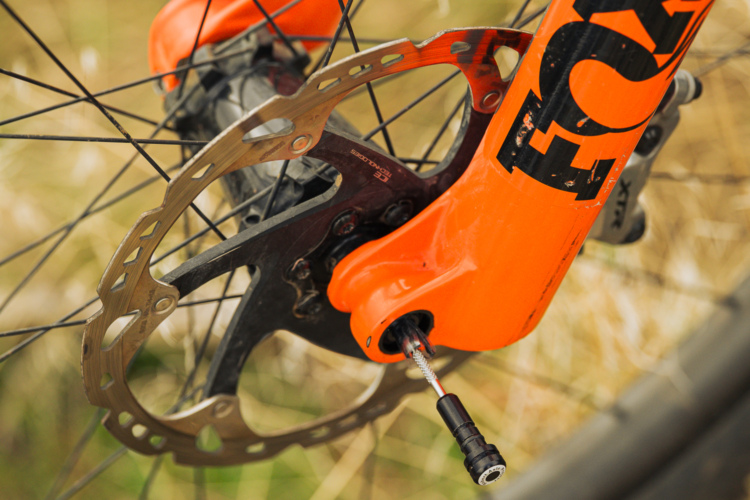
The downhill World Cup course in Andorra was all new this year. Much of the track was similar to what you’d see on any other World Cup course: high-speed jumps and fast berms in the wide open sun and shaded technical sections with rock gardens, stumps, and chunder.
As riders got farther down the course though, they ran into three bridges hovering over service roads which could be utilized for emergency vehicles. The bridges, built of scaffolding, rattled as athletes sped down them. The first had a hard 90° left turn. Another was a straight shot across the road and dropped back onto natural surface. The last bridge carried riders into a right-hand turn and down a drop into the finish corral. The left side of the drop was covered in padding. The surface of the bridges was covered in rubber mats.
As temperatures heated up into the 100s that weekend, the rubber softened.
“All the bridges were kind of sketchy,” said Neko Mulally in an interview with Singletracks.
Though most of the riders carried their speed with enough precision to avoid major injury, the sharp, walled-turn into the drop made for some wild finishes and a crash that threw junior racer Remy Meier-Smith into the ground and away from a “podium finish,” according to Meier-Smith’s Instagram.
“This rubber stuff is super unpredictable,” commented Jackson Goldstone in a course preview on Red Bull’s YouTube channel two days ahead of the race. “Very hard to ride.”
A time for change
As the World Cup downhill season comes to a close soon, the UCI will move on from their partnership with Red Bull as the exclusive broadcaster and in 2023, the UCI will partner with the Enduro Sports Organisation (ESO) and Warner Bros. Discovery for an 8-year deal to broadcast the UCI mountain bike World Cup. With the deal, fans will lose beloved commentator Rob Warner and it’s unclear yet if viewers will need to pay for a subscription service to continue watching, or if the races will be available for free.
For athletes, the whirlwind of change is the perfect time to try and get more stake in the game. Earlier this season, Loic Bruni and Finn Iles recorded a podcast with Dean Lucas about the need for what’s been called a riders’ union.
“I felt like it was urgent because everything is going fast,” Bruni told Lucas, referencing the short amount of time between the remainder of the season and the new partnership with ESO and Warner Bros. The driving force behind the proposed association are features like the bridges in Andorra where athletes might feel the course poses an unnecessary risk. Bruni and Iles couldn’t be reached for comment.
“I think it would be a good thing no matter what,” Mulally told Singletracks. “The big thing that is always a discussion between the riders and the organizers is the track stuff. It’s track safety stuff and it extends past safety and sometimes gets to opinion, but the riders are always arguing about the courses — the downhill riders anyway.”
Currently, most of the discussion happens in a WhatsApp group between many of the riders, and the opinions are hardly unanimous. Some athletes might encourage others to suck it up and ride part of a track they don’t like. Others might call for changes. With opinions all over the board, it’s hard to have a unified decision to present to a course organizer and ask for change.
With an association of downhill athletes, riders would vote on a debated track feature. If the majority of riders vote that the feature feels unsafe, then they would take the decision to a technical delegate or correspondent. Currently, that person is Jorge Garcia who works for the UCI and with local course organizers to ensure course safety, but that may change next season. Even as the technical delegate and former downhill athlete, it’s not always possible for Garcia to accurately and solely judge track conditions.
“Improving safety in a sport like DH is not easy,” Garcia told BikeRumor in February. “You must consider a lot of factors and variables. Even with a thousand eyes on it, walking the circuit 15 times in a week isn’t enough. A jump that looks perfect, tested at the real speed the riders are going through, can turn into a very dangerous jump. That’s how it really is, until it’s tested in action you can’t see where there are potentially dangerous spots.”
With the association, riders would try to have suggestions in well ahead of the race so that sections like the bridges in Andorra could be resolved sooner. By the day of track walk, it’s usually too late.
In the event the riders vote to change something and the course isn’t altered is where it might get sticky.

“I don’t ever want to get to a situation where we’re not racing, trying to use the leverage that we have against the organizers,” said Mulally. “Nobody wants to do that. Any situation where we’ve had [an issue], the organizer wants to make it right. Often there’s just not enough time and resources to make it right at the time they know about it.”
There has also been contention over the consistency of course marshals and how well they’re trained. Sometimes a course marshal might throw the wrong colored flag down when there’s a crash ahead on practice day. In Lucas’s podcast, Iles mentioned he had been yelled at by a marshal for moving a loose rock off the track and said marshals could be briefed better.
As a race organizer himself, Mulally said it can be tough for organizers to fill dozens of these volunteer positions, and those who do volunteer may not be very familiar with downhill mountain biking.
“Getting volunteers to show up on time and follow directions is really difficult,” said Mulally. “I think they have good intentions, but a guy that came out on his Thursday to marshal your practice in exchange for a free sandwich might not be the most up to date on how to flag the practice or know exactly what’s going on.”
A brief history of sports unions
Sports unions aren’t new. In the United States they date back to the late 1800s with the Brotherhood of Professional Baseball Players. The union wanted to increase salaries and reduce the amount of control that team owners had over the players at a time when the sport’s popularity was increasing.
Sports unions, like labor unions, have largely argued for the same thing: better salaries and pensions and fairer working conditions. Vice notes that the Brotherhood had some initial success and salary increases, but ultimately it wasn’t until the 1960s when players had a solid union on their hands and could collectively bargain for better salaries. Finally in 1975, baseball players could enter free agency.
The World Cup riders’ union would be different since they aren’t necessarily trying to leverage their power for better pay but for the opportunity to speak out and create change when they feel unsafe on a given course.
On track for change
Speaking between the race in Andorra and the World Champs in Les Gets, Mulally said there have been several meetings at each venue thus far and he feels the discussion is going well. Ideally, the association would have a central point of contact who isn’t a competing athlete and takes notes at each meeting and can coordinate with course delegates or organizers.
Still, there are a lot of details to work out and things would likely finalize over the off-season.
Mulally, like the other World Cup athletes, hasn’t been briefed on anything about the 2023 season and the transition to ESO and Warner Bros., aside from the schedule which was released two weeks ago. Though the release touts a lighter carbon footprint, Mulally, now competing on a frame he designed with Frank the Welder and garnering support from other sponsors, is excited he’ll spend less time and money flying back and forth from Europe. This year he made the journey over the Atlantic five times.
When it comes to the union, Mulally insists the word in their context isn’t all that frightening.
“It’s not as serious as people might think when they hear the word union,” he said. “It’s more just the riders trying to organize themselves better, rather than it being afterwards. And I’ll say 95% of it is track-related and safety.”





















2 Comments
Aug 26, 2022
Losing Rob Warner next year is a major disappointment.
Aug 27, 2022